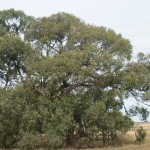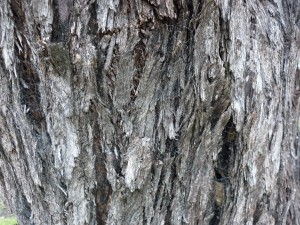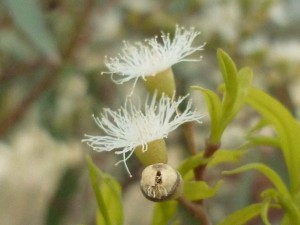What’s in a name?
The names of living things are chosen to tell us something about their features.
What features does a ‘Black Box’ or Eucalyptus largiflorens’ have in its ‘Common’ and Scientific names? If you already know why this tree is called a Black Box, you can skip the Common Name section and jump ahead to Scientific names
Let’s start with the Common Name – ‘Black Box’
‘Black’ tells us about the colour of its bark.
1 Does a Black Box look ‘black’ in these photos – from a distance, above, or close-up, below?
‘Box’ tells us which of the four main groups of Eucalyptus trees it is.
What is a ‘box’? It’s a bark type.
- 2 How would you describe the bark in the photo?
- 3 How do you think it would feel to touch it?
- 4 Does it look like this bark would peel off, flake off or just fall off in fibres?
(Click here if you need to check your answers.)
Eucalyptus trees lose their bark each year. ‘Box‘ is the group of Eucalptus trees with bark so thick, rough and cracked, that it comes off in small bits of fibre.
Scientific Names
Now for the Scientific name- Eucalyptus largiflorens.
Eucalyptus
There is a big group of Australian trees called Eucalyptus. They all have gumnuts. Gumnuts have key parts that change overtime: caps, blossum, fruits. Let’s look close up at some Black Box Gum blossom first.
-
- 5 Look carefully at the white circle in front. What is happening here?
- 6 How many parts are there to the open flower? Can you name them all? Do you know what they do?
The basic changes in a gum nut are from this ![]() to this
to this  . Why?
. Why?
- They start as buds, with a cap on top and a cup under it. (as in the diagram)
- The cap falls off to let the flower out (see one cap starting to break apart in the photo above).
- The flower sits in the cup.
- The flower has a group of ‘strings’ that are called stamen.
- 7 About how many stamen are on one flower in the photo above?
- The stamen have a dot at the end called the antherm which is where the pollenis found.
- 8 What do the anthers look like on the blossom photo above?
- The plants needs something else to take pollen from flower to flower to start the process of making new seeds.
- The tree offers nectar to birds and insects which is found inside the cup.
- To get in there, they touch the stamens and anthers.
- As they do, they collect or deposit pollen on different flowers.
- This mixing and moving of pollen is called pollination and it is needed to make seeds. (Isn’t that an amazing linkage between the birds, insects and trees getting what they need from and helping each other?)
- When the pollen has been shared, the flower will wilt.
- As the flowers dry up, the seeds form in the cups.
- The cups close up to take care of them until the conditions are right for them to open again and fall onto the ground.
- These dried up cups are called fruits –or you may more commonly call them ‘gumnuts’.
(Click here if you need to check your answers .)
largiflorens
The meaning of ‘largiflorens’ is a lot more difficult, if you don’t know the old languages from which these words come. But they are languages that led to English today, so sometimes you can work it out a bit, if you break the word up and see what is similar today.
Does largi look a bit like ‘large’ and Florens a bit like ‘flower’?
Let’s look at branch of Black Box blossum –
9 Do these flowers look large or does it look like there is a large number of them?
Hey, we got there! Largiflorens actually means ‘abundant flowers’. About 150 years ago, a botanist named Mueller gave this tree this name because it was so well covered in blossom!
(Click here if you need to check your answers.)
Continue on to Features of a Black Box (Eucalyptus largiflorens)
Return to main Black Box page
Page updated 15 Jan 2013
Supporter of
 and
and 




